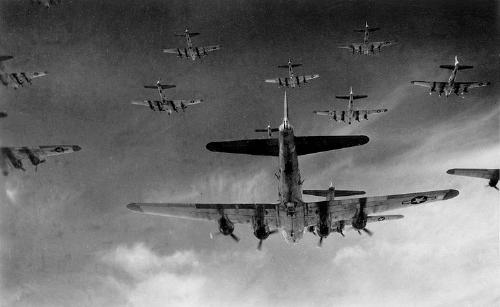World War II: War on the Western Front
World War II: War on the Western Front
 The air war in the European Theatre commenced in 1939, with U.S. Army Air Forces units being deployed to England to join the assault on Germany on July 4th, 1942.
The air war in the European Theatre commenced in 1939, with U.S. Army Air Forces units being deployed to England to join the assault on Germany on July 4th, 1942.
Prewar doctrine had held that waves of bombers hitting enemy cities would cause mass panic and the rapid collapse of the enemy. As a result, the Royal Air Force had built up a large strategic bomber force. By way of contrast, Nazi German air force doctrine was almost totally dedicated to supporting the army. Therefore, German bombers were smaller than their British equivalents, and Germany never developed a fully successful four engined heavy bomber equivalent to the Lancaster or B-17.
The main concentration of German raids on British cities was from September 7th, 1940 until May 10th, 1941. After that most of the strength of the Luftwaffe was diverted to the war against the Soviet Union. German raids continued on a smaller and less destructive scale for the rest of the war, and later the V1 Flying Bomb and V-2 ballistic missile were both used against Britain. However, the balance of bomb tonnage being dropped shifted greatly in favor of the RAF as Bomber Command gained in strength. By 1942, Bomber Command could put 1,000 bombers over one German city. From 1942 onwards, the efforts of Bomber Command were supplemented by the Eighth Air Force of the United States Army Air Forces. Bomber Command raided by night and the US forces by day. On February 14th, 1945, a raid on Dresden produced one of the most devastating fires in history. A firestorm was created in the city, and between 25,000 to 35,000 people were killed. Only the raids on Hamburg (July 24th, 1943 - July 29th, 1943), the firebombing of Tokyo and the nuclear attacks on Hiroshima (August 6th, 1945) and Nagasaki (August 9th, 1945) killed more people through a single attack.
|







 The air war in the European Theatre commenced in 1939, with U.S. Army Air Forces units being deployed to England to join the assault on Germany on July 4th, 1942.
The air war in the European Theatre commenced in 1939, with U.S. Army Air Forces units being deployed to England to join the assault on Germany on July 4th, 1942.